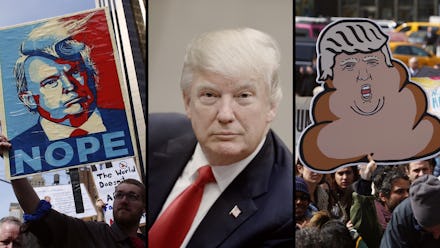Last time a US president faced such resistance in his first 100 days, civil war broke out

As President Donald Trump closes out his first 100 days in office, much is being made his legislative misses and broken promises.
But there's something else that distinguishes Trump's early presidency from those of his predecessors. In his first 100 days in office, Trump has seen some of the most intense backlash of any American president at this point in his term.
"It's [the protests] in the first 100 days that I think distinguishes Donald Trump," Brian Balogh, associate professor of history at the University of Virginia and cohost of the popular U.S. history podcast Backstory, said in an interview.
"Certainly Richard Nixon experienced massive protests — anti-war protests and all kinds of protests — over the course of his administration," Balogh said. "But I certainly can't recall any president facing the kind of persistent series of protests from a broad cross section of America this early in their administration."
Indeed, the resistance to Trump's White House has already broken records. The day after his inauguration, protesters held the largest single-day demonstration in history, with almost 500,000 people marching in Washington D.C. alone and at least 4.2 million people marching nationwide. Rallies since then have consistently drawn tens of thousands of people eager to show their opposition to the president and his agenda.
In addition to such significant crowds, Trump is also historically unpopular in the polls. "Trump is now at 40% at the hundred-day mark," Barbara Perry, director of presidential studies at the University of Virginia's Miller Center, said. "That is 15 points below the closest lowest approval rating, and that is Bill Clinton."
Perry was careful to note that public opinion polling in the first 100 days only dates back to the administration of Dwight D. Eisenhower in the 1950s. But when asked whether there were other presidents whose first hundred days were marked by such tension, Perry and Balogh both cited a moment much more fundamental to the nation's history.
"Lincoln had the worst first hundred days ever because the country split apart and sank into civil war," Perry said. "To be graphic about it, that is the worst example. That's as grassroots as you can get."
Although the early backlash to Trump's presidency is happening on a scale that hasn't been seen in more than 150 years, some historians caution against seeing the opposition to Trump as a new phenomenon. Julian Zelizer, professor of history and public affairs at Princeton University, noted that many recent presidents have faced considerable backlash upon entering office.
"President Obama faced Republican mobilization from the moment he took office, both at the grassroots level with the formation of the Tea Party to Congress," Zelizer said, noting the Trump resistance movement has used the Tea Party as a model for how to oppose a president's agenda.
"A lot of presidents had fierce resistance," Zelizer continued. "Bill Clinton had this for sure in the early 1990s, from conservative talk radio to Republicans on Capitol Hill. [Trump] is more disliked than most presidents and he clearly elicits a level of anger that we don't always see, but we shouldn't underestimate in our polarized era of politics just how anxious the losing side often is in the months that follow the election."
But if the resistance to Trump's administration is somewhere between the typical backlash faced by new presidents and the historic unrest of the Civil War, that leaves a lot of room for uncertainty.
"Here would be my question: How massive is the resistance to Trump?" Perry said, noting 100 days may not be enough to know the answer. "The first measurement of that will be the 2018 midterms. Then and only then will we know the exact impact of the resistance against him."
That is to say, If the resistance is dead-set on change, it should be preparing for a long, drawn-out battle.